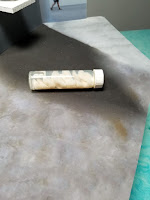Extra Credit Event 2: Coyotes in Two Directions, Sarah Brady
 I visited Sarah Brady exhibition opening: Coyotes in Two Directions on June 7 at Art | Sci Center Gallery, CNSI Building at UCLA. I did not know about the Coyotes, before I attended to this event. According to the researches, Coyote is an animal, canine. They look similar to wolves. According to the explanation by Sarah Brady, this exhibition examines the signifier of the trickster and shapeshifter as a symbolic metaphor to create techno-hybrid forms. They said coyotes are the symbol of mythology and surviving under Anthropocene, the human impact on Eco-System. First time, I get this information I did not really get what does this statement mean. However, as soon as I saw the art crafts, I recognized the meaning of this statement.
I visited Sarah Brady exhibition opening: Coyotes in Two Directions on June 7 at Art | Sci Center Gallery, CNSI Building at UCLA. I did not know about the Coyotes, before I attended to this event. According to the researches, Coyote is an animal, canine. They look similar to wolves. According to the explanation by Sarah Brady, this exhibition examines the signifier of the trickster and shapeshifter as a symbolic metaphor to create techno-hybrid forms. They said coyotes are the symbol of mythology and surviving under Anthropocene, the human impact on Eco-System. First time, I get this information I did not really get what does this statement mean. However, as soon as I saw the art crafts, I recognized the meaning of this statement.
As I entered the exhibition, this one came in my sight first. I think this is the thing I saw at the earlier exhibition, Weak or No Signal. This craft was named as "Aposematic". It has one leg and six moving arms. The difference between the Aposematic and this craft is the background and the tip of the arms. Aposematic was expressing the desert, animist and virus. At the background, there was a spooky object on the floor to express the virus. (You can see it on my Extra Credit Event 1 Post) The tip of the arms, now have sharp nails that is demonstrating the coyote's nail. I was inspired that the similar craft could be expressed in such different ways by the slight changes.


This is the picture of me, with the sticks that have the legs of coyotes on the both edges of the sticks. At the first time seeing this, It looked like a spear for me. The picture on the right, again looked like a spear for me, however on the top of this, there was a circle-shaped that looks like a rattlesnake's tail and I researched about the rattlesnake. As soon as I researched on online, I could see common feature. They are all different in shapes, and characteristics. However, they are the predators in their habitat.

As they explained earlier, coyotes are surviving under Anthropocene which is the circumstance that human created. Nowadays, because of the pollution caused by humans such as night light pollution, and global warming, many species of the animals are extinct. However these two species are predators and surviving right now.
Rattlesnake, https://en.wikipedia.org/
I was kind of disappointing because there were only three art crafts that I can look at. I hope that I could see more of this kind of craft at the exhibition. Even thought, there were only three of them, It was really interesting to look at, think about and research about them. I could recall that Leonardo Art Science Evening Rendezvous event, that was explained about ALAN, Artificial light at night. It reminded me of the interactions between science and art as well. Since the science is developed, they can create a machine that has moving arms. Since the environmental science is developed the coyote and the rattlesnake are able to be compared and see the similarities. This is going to be pretty much the last post that I am going to post for this course. This exhibition was excellent to help me on reminding about the earlier lectures and events that I have attended.
Work Cited:
Bradford, Alina. “Coyote Facts.” LiveScience, Purch, 25 Sept. 2017, www.livescience.com/27976-coyotes.html.
“Coyote.” National Geographic, 10 May 2011, www.nationalgeographic.com/animals/mammals/c/coyote/.
Dibbets. “Interactions between Science and Art | Cardiovascular Research | Oxford Academic.” OUP Academic, Oxford University Press, 1 Dec. 2002, academic.oup.com/cardiovascres/article/56/3/330/272141.
Rao, Joe. “Light Pollution Is a Big Problem, But You Can Help.” Space.com, Space.com, 22 Feb. 2018, www.space.com/39787-light-pollution-problem-you-can-help.html.
“Rattlesnake.” Wikipedia, Wikimedia Foundation, 7 June 2018, en.wikipedia.org/wiki/Rattlesnake.
Bradford, Alina. “Coyote Facts.” LiveScience, Purch, 25 Sept. 2017, www.livescience.com/27976-coyotes.html.
“Coyote.” National Geographic, 10 May 2011, www.nationalgeographic.com/animals/mammals/c/coyote/.
Dibbets. “Interactions between Science and Art | Cardiovascular Research | Oxford Academic.” OUP Academic, Oxford University Press, 1 Dec. 2002, academic.oup.com/cardiovascres/article/56/3/330/272141.
Rao, Joe. “Light Pollution Is a Big Problem, But You Can Help.” Space.com, Space.com, 22 Feb. 2018, www.space.com/39787-light-pollution-problem-you-can-help.html.
“Rattlesnake.” Wikipedia, Wikimedia Foundation, 7 June 2018, en.wikipedia.org/wiki/Rattlesnake.



Comments
Post a Comment